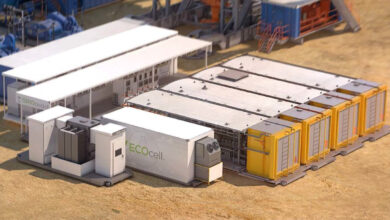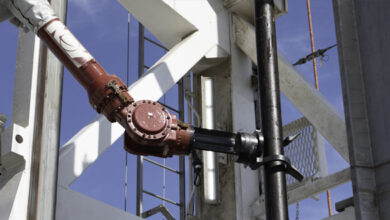By Diane Langley, editorial coordinator
Hydraulic fracturing has been an area of aggressive research and development over the past several years, with operators and service companies introducing a number of “green” technologies as a response to public concerns and as part of the effort to improve well economics. Hydraulic fracturing to restore or enhance well productivity is performed in all types of formations and reservoirs and has become a high-profile operation as a result of its increased use in the prolific shale plays in North America and in other unconventional reservoirs.
Halliburton, Baker Hughes, Schlumberger, Weatherford International, GasFrac Energy Services, Universal Well Services and Frac Tech Services spoke with Drilling Contractor about the environmental aspects of hydraulic fracturing and “green” developments. These developments primarily address concerns of potential drinking water contamination, toxic chemical use and water use in fracturing operations.
According to Harold Brannon, pressure pumping senior advisor for Baker Hughes, fracturing is far and away the most efficient stimulation technique. Aside from its application in shales, hydraulic fracturing allows for drilling of fewer wells and can more effectively drain a given reservoir. Shales and most unconventional wells could not be successfully and economically produced without hydraulic fracturing stimulation.
“The US and North America in general is blessed with the most prolific shale formations on the planet,” he said. “Well stimulation makes the recoverable cost of hydrocarbons beyond what alternative energies can even approach. The cost is a fraction of what it is for nuclear, solar or wind.”
For those who question whether the hydraulic fracturing technique must be used at all, the answer is yes; it is the most common method used today to stimulate a well in tight sands, shale and coalbed methane. It is an economic way to improve productivity.
The size of the area drained by a hydraulically fractured well is larger than wells that are not stimulated by the process. And, according to the Independent Petroleum Association of America, fewer wells need to be drilled if hydraulic fracturing is used.
Service providers are anything but complacent about the process and have improved the technology to meet the needs of producers and address environmentalists’ concerns.
Schlumberger
Hydraulic fracturing technology has advanced significantly in the 60-plus years it’s been around. According to Ted Lafferty, vice president of stimulation services for Schlumberger, historically the most important hydraulic fracturing technology developments have been in the area of fracture diagnostics. The introduction of pressure transient and net pressure analyses in the 1970s and ’80s provided the first link between well performance and fracture geometry and conductivity.
The development of analytical reservoir simulation techniques provided a means to more rigorously model and evaluate fractured well performance. With the development of RA tracers, measuring the near-wellbore behavior of hydraulic fracture treatments became possible.
“The most enlightening fracture diagnostic to date has been microseismic mapping, which has shown a surprising diversity in fracture growth and played a key role in advancing shale gas development,” Mr Lafferty said.
Microseismic mapping has shown that fracture growth can be much more complex than initially envisioned and has led to the understanding that fracturing complexity can be the key to economic success in some shale plays.
“We have seen significant improvements in our ability to model hydraulic fracture growth, from simple 2D models in the 1980s to widespread application of pseudo/lumped 3D models and fully 3D models in the 1990s,” Mr Lafferty said. “Our fracture-modeling capabilities have taken another major step forward with the recent introduction of complex fracture models that address the interaction of the hydraulic fracture with natural fractures. However, the industry still struggles with the integration of hydraulic-fracture modeling, G&G modeling and production simulation, resulting in predictable well performance.”
Advances in proppant and fluid technology in the 1980s contributed to the tight-gas boom. The application of hydraulic fracturing expanded with the introduction of high-strength sintered bauxite and intermediate strength ceramics and resin-coated proppants and the development of cross-linked fracturing fluids. Foamed, emulsified, alcohol and oil-based fluids also were developed for water-sensitive and underpressured reservoirs.
According to Mr Lafferty, the industry’s understanding of fracturing conductivity has improved dramatically in the past 60 years, with lab and field data suggesting that there could be significant reductions in conductivity due to stimulation fluid additives (e.g., polymers), embedment, non-Darcy flow and multiphase flow. These insights have led to the development of encapsulated breakers and advancements in novel fracture construction processes. Tip screen-out fracture designs for higher-permeability reservoirs contributed to the application of hydraulic fracturing in offshore environments, including sand-control applications and horizontal wells.
Improvements in multistage completion technologies and processes over the past 10 years have enabled large-scale development of many tight-gas and most shale-gas resources where 15-plus fracture treatment stages are now common practice in both vertical and horizontal wells. These improvements include drillable and flow-through bridge plugs, coiled-tubing perforating and fracturing, pump-down plug and perf operations and other uncemented isolation systems.
“One notable improvement was the introduction of a continuous mix system in the 1980s, eliminating the need to batch-mix large volumes of fluid,” Mr Lafferty said. Topside metering and measurement technology has also improved, including the use of mass and magnetic flow meters to monitor additives, on-site viscometers, computer data acquisition and control, and remote data transmission via satellites.
“Although there have been significant advances in hydraulic fracturing technology, there is still considerable uncertainty when relating fracture design to well performance. This uncertainty is partly due to the variability and heterogeneity of the reservoirs we are stimulating, but the industry continues to be fragmented when it comes to the evaluation of hydraulic fracture growth and well performance,” Mr Lafferty said. “We still lack routine and accurate measurements or reservoir characteristics in unconventional reservoirs. In addition, even when data are available, it is often not fully utilized.”
He believes that future advances in hydraulic fracturing will likely result from the routine integration of G&G, reservoir and production data. This is achieved with fracture diagnostic measurements, geomechanical models and advanced fracture models.
“Schlumberger takes the concerns and regulations of the environments we work in extremely seriously,” said Mr Lafferty, who added that the company has continued to advance chemistries that are favorable from an environmental perspective. In 2010, the company commercialized the OpenFrac fully disclosed hydraulic fracturing fluids, a family of fluids that avoid the use of analytes listed on the US EPA Priority Pollutants and National Primary Drinking Water Contaminants.
Although chemistry has traditionally been the means of achieving fluid performance in hydraulic fracturing, the company is looking for improvements in non-chemical processes, such as bacteria control, proppant transport and proppant flowback control, as well as new approaches in hydraulic fracture construction. The most recent service is the Schlumberger HiWAY hydraulic fracturing technique, which is a process for fracture construction that delivers a step-change in fracture conductivity and uses 45% less proppant material.
Several of these technologies were introduced over the past decade and include the proppant-pack additives to prevent flowback in the reservoir and fracturing fluids that create a fiber-based network within the fracturing fluid, providing a mechanical means to transport, suspend and place the proppant.
Halliburton
Potential contamination of drinking water aquifers as a result of hydraulic fracturing is the key issue that has been debated for years by environmentalist groups and communities in which the technique is being used.
According to David Adams, vice president of product enhancement for Halliburton, the first step to protecting drinking water aquifers is providing adequate casing and zonal isolation in wellbores.
“We, as an industry, have to be sure these two items are completed,” he said. “The other thing we must be cognizant of is that perforating takes place in the hydrocarbon production sections of the wellbore.”
From a hydraulic fracturing perspective, there are additional means of protecting water aquifers – environmentally conscious chemistry, monitoring the path of treatments using microseismics and replacing biocides with ultraviolet light. Halliburton has introduced CleanSuite technologies – including CleanStim, CleanStream and CleanWave – in addition to 3D subsurface fracture mapping and dry polymer blending technology. In an effort to be transparent when it comes to the fracturing process, the company has also launched a micro-website that details what components are used during its fracturing process and compares them with common household products.
The CleanStim fracturing fluid is made with ingredients sourced from the food industry, offering an extra margin of safety if there is an incident at the wellsite. The product is not edible, but it does include a complete frac fluid system offering, a gelling agent, crosslinker/ buffer, breakers and a surfactant. Each of these components are rooted in the US Food and Drug Administration’s CFR 21 list, which defines foods for human consumption.
The amount of chemistries present on site has also been reduced. “Once we’re on location, we go to extreme measures to ensure that there is no spillage on the surface,” Mr Adams said. “We also monitor the pressures and rate to determine the characteristics of the fracture downhole.”
Halliburton’s Advanced Dry Polymer Blender, in use in roughly 40% to 50% of the company’s North American stimulation fleet, eliminates the need to use mineral oil as a carrier mechanism to deliver the gelling agent to the fluid system. Use of this blender has conservatively eliminated more than 10 million gallons of mineral oil from fracturing treatments in 2010, according to Mr Adams.
The company also uses an electrocoagulation technology to treat frac or flowback water on site for re-use. It features a mobile electrocoagulation unit that uses electricity to treat up to 26,000 bbl/day of water.
A new container system, called a SandCastle, is also in use to store proppants in a vertical state, enabling delivery by gravity into the fluid system. In the past, conveyor belts with hydraulic engines were used; eliminating the engine has resulted in reduced emissions on site.
Baker Hughes
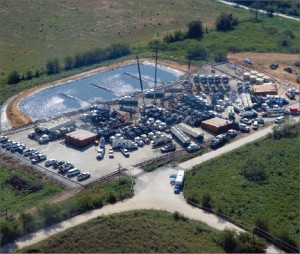
Baker Hughes agrees that the first and foremost method of protecting water aquifers is the use of best practices for well construction – good cementing and casing jobs. A secondary method is to evaluate the environmental efficacy of additives, a process that the company began about a year and half ago in conjunction with Entrix, an environmental consulting firm. The BJ SmartCare system gives Baker Hughes the ability “to assess the products that we had and identify suitable alternatives which we could run through the same process and get an environmental footprint of them,” Mr Brannon, pressure pumping senior advisor for the company, said.
“We see the SmartCare selection system being pervasive throughout all of our pumping operations,” Mr Brannon said. “We’re taking a proactive step in trying to address cementing, acidizing, well completion processes, and all the various chemicals we might pump downhole, and ultimately have all those be green.”
“We’ve been able to do so in the fracturing treatments without really adding to the cost, which was a concern going in for us and for most operators,” he said.
Passive microseismic technology is also used to monitor subsurface fractures as they are being created. Should a fracture begin to develop in an unwanted direction, that fracturing stage can be shut down immediately. “It gives the information in real time of whether or not you are approaching a hazard and to shut down the treatment,” Mr Brannon said.
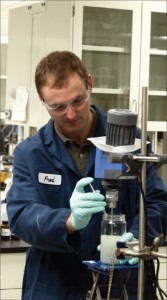
Going beyond the chemicals, a process involving ultra-high quality foams is being used to minimize the amount of water needed in the fracturing treatment by 95%, which also reduces truck traffic at the wellsite. Baker Hughes’ VaporFrac fracturing fluid also eliminates post-frac cleanup, water disposal costs, frac tank rentals, sand haulers and proportioning units. Further, the lack of polymer residue means there’s virtually no formation damage. According to Mr Brannon, the process is already being used successfully on vertical wells in New York.
The company is also working on water treatment systems, including thermal evaporation technology. “We’re also using viscoelastic surfactants and recovering viscosified fluids that can be recycled. The limitation is that we only get a maximum of 30% of the fluid back when the treatment is completed,” Mr Brannon said.
Weatherford International
When it comes to protecting drinking water aquifers, Steve King, US sales and technical manager for Weatherford, cites proper drilling, casing and cementing programs as the primary protection mechanism, along with the fact that these aquifers are typically shallow and close to the surface. “The intervals in which we perform hydraulic fracturing treatments are very deep, so you literally have thousands of feet of separation between the drinking water aquifer and the reservoir rock that is undergoing fracturing treatment,” he said.
There are two additional lines of defense in protecting drinking water aquifers: monitoring the rate and pressure of the fracturing treatment and the use of microseismic techniques. “Specifically, we monitor the process in real time, taking injection rates and pressures at which the treatment goes into the ground. Any abrupt change in rate or pressure is an indication that the process is going somewhere unanticipated,” Mr King said. “Any job can be easily stopped if those rates and pressures are not what were predicted.”
Mr King said his company is “taking a closer look at the (environmental) requirements that are in place and projecting those requirements into the future. For example, what will those requirements be in six months?”
With regard to reclamation and re-use of frac water, Weatherford’s Johnson Screens division reclaims water through a two-step process that involves the physical separation of the solids from the water and further filtering and clarification. “The distillation process has been around for a long time, but it’s never been an economical solution,” Mr King said. “But in today’s terms, as water becomes more difficult to acquire and the expense of acquiring, recovering and disposal increases, the cost of distillation may become an option.”
GasFrac Energy Services
Calgary-based GasFrac Energy Services takes a different approach to hydraulic fracturing that eliminates the need for water use, cleanup and disposal. According to Robert Lestz, GasFrac chief technology officer, the company has completely removed the need to use water in the fracturing process. Rather than using water treated with chemicals, it uses 100% liquefied petroleum gas (LPG) gelled with proprietary chemicals.
The use of LPG evolved as the result of an evaluation process that was undertaken in 2000 to find the cause of well underperformance, said Mr Lestz, who previously worked with Chevron. Although the wells that were being fractured may have been economic successes, from a pure technical perspective, they were underperforming. “We came to understand that it was because we were using water-based fluids. In lower-permeability, tighter reservoirs, the use of water became more damaging or created sub-optimal performance after stimulation,” he said.
The effort to arrive at a better stimulation solution set out to remove water from the equation, Mr Lestz said, “but it was not an issue of water supply or potential for water contamination but more so it was about reservoir performance.”
The removal of water from the fracturing process serves more than an environmental function. “There are fewer impurities with which to contend,” Mr Lestz explained. “Water may contain impurities that affect viscosity. However, LPG is a refined product having minimum impurities. When gelled with GasFrac proprietary chemicals, it has a consistent viscosity.”
Another benefit to using LPG is that it occurs naturally in gas wells and results in little or no formation damage. Adding water to undersaturated reservoirs can reduce and impair its effective permeability, Mr Lestz said. “We describe the process to landowners as ‘not even a drop is needed,’” he continued. “We’re using a natural gas byproduct to produce more natural gas and oil. It’s a closed-loop, sustainable and recyclable process with 70% to 80% of the LPG recovered in the first week.”
According to Mr Lestz, there are no carcinogens in the proprietary chemicals used to gel the LPG. In fact, one of the additives is used in antacid pills and another is used in water treatment plants; no biocide is required.
Universal Well Services
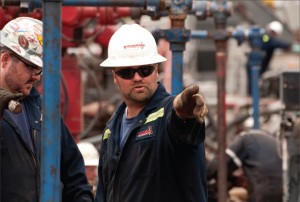
“There’s never been a greater time of innovation in our industry. This innovation is being driven by the fact that this shale resource is truly a world-class reservoir. Rather than working towards wringing more out of dwindling reserves, we now have a paradigm shift that makes investment in new techniques an appealing target,” Roger Willis, president of Pennsylvania-based Universal Well Services, said.
“People all over the world are seeing that shale is a development of historic proportions. We’re seeing companies getting into this business that would have in the past seen American energy development as a backwater,” he said.
Universal Well Services’ market niche is providing on-site hydraulic fracturing expertise in addition to sand handling, blending and high-horsepower pumping equipment and piping packages. “From a product development standpoint within this industry segment, we’re seeing innovation occurring at a breathtaking rate right now, and it’s coming from more suppliers than we’ve seen in the past,” Mr Willis said.
“We’re seeing interest from every degree of the spectrum of companies with which we partner, whether they’re developing pumps, additives or electronic components. … It gives us the ability to have much greater choices with the idea of environment in mind.”
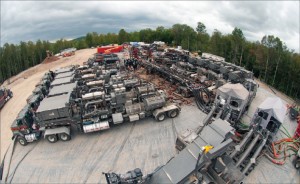
One additive that the company is looking to replace is winterizing agents used to keep liquid material from freezing and replace them with benign substances, Mr Willis said. “We’re also working on the use of dry products to eliminate the need to use a winterizing agent and not have to worry about a liquid phase.”
According to Mr Willis, there’s now a whole palette of technologies that can enable evaluation, monitoring and measuring the geometries of fractures as they are created. “This gives us the ability to apply much stronger design techniques and to better link the creation of the fracture in with the things that we can control, such as the type of fluids that we pump, the rates at which we pump, the orientation of the casing and how the fracture propagates in the ground.”
“Our job, creating the fracture in the ground, is a complex process; I think the pace of refinement in hydraulic fracturing techniques is right now at the steepest it’s ever been,” Mr Willis commented, adding that the bulk of research and development expenditures at the company is focused on environmental protection.
“At every turn we are trying to answer questions. We’re spending an inordinate amount of time making sure that, if someone has a question, there is someone there to answer it truthfully in a form that’s understandable and defendable.”
Frac Tech Services
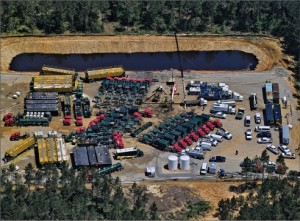
Frac Tech Services, headquartered in Cisco, Texas, is solely focused on providing hydraulic fracturing and well stimulation services and owns sand mines and resin-coating facilities. The company recently introduced a dry formulation, Slickwater Green, to its family of environmentally friendly products that eliminates the need for many liquid products currently used in hydraulic fracturing, according to Brad Holms, senior vice president of marketing and technology for the company. This reduces the amount of truck traffic to the wellsite.
The company also has introduced Venus Green, an emulsified acid that uses an environmentally friendly formulation to stimulate carbonate reservoirs. “Some of the ingredients in our products are actually also used in the cosmetics and food industries,” Mr Holms said.
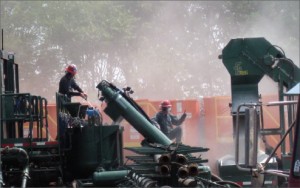
The company is also exploring the development and use of thermal evaporative technologies for water conservation. Testing of the new Slickwater Green fluid has demonstrated that it can be used with recycled water.
“The introduction of nanoparticle dispersion (NPD) is a prime example of our quest for new technology development,” Mr Holms said. NPD is used to separate hydrocarbons from rock, especially in older existing wells, and has been used to clean up injection and disposal wells, to clean up formation damage and in water block removal, he explained. “Over the next years, major leaps in nanotechnology will offer substantial improvements in efforts to improve production.”
OpenFRAC and HiWAY are marks of Schlumberger.



